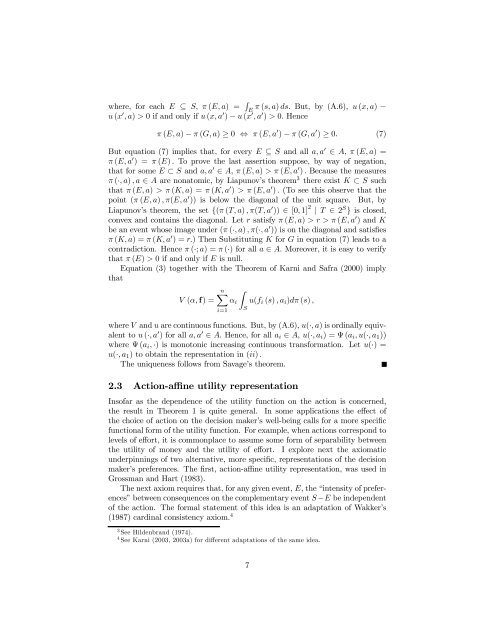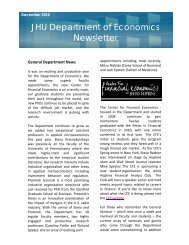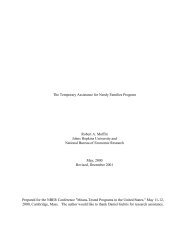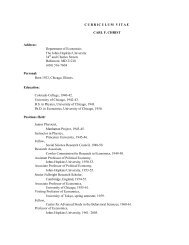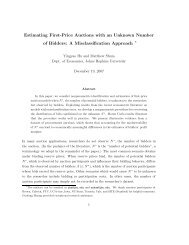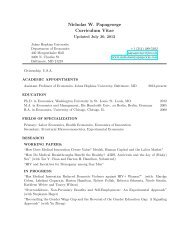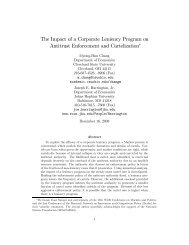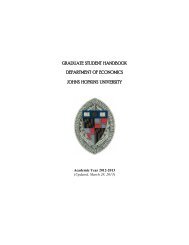Subjective Expected Utility Theory with Costly Actions - Economics ...
Subjective Expected Utility Theory with Costly Actions - Economics ...
Subjective Expected Utility Theory with Costly Actions - Economics ...
You also want an ePaper? Increase the reach of your titles
YUMPU automatically turns print PDFs into web optimized ePapers that Google loves.
where, for each E µ S; ¼ (E;a) = R<br />
E<br />
u (x0 ;a) > 0 if and only if u (x; a0 ) ¡ u (x0 ;a0 ) > 0: Hence<br />
¼ (s; a) ds: But, by (A.6), u (x; a) ¡<br />
¼ (E;a) ¡ ¼ (G; a) ¸ 0 , ¼ (E;a 0 ) ¡ ¼ (G; a 0 ) ¸ 0: (7)<br />
But equation (7) implies that, for every E µ S and all a; a 0 2 A; ¼ (E;a) =<br />
¼ (E;a 0 ) = ¼ (E) : To prove the last assertion suppose, by way of negation,<br />
that for some E ½ S and a; a 0 2 A; ¼ (E;a) >¼(E;a 0 ) : Because the measures<br />
¼ (¢;a) ;a 2 A are nonatomic, by Liapunov’s theorem 3 there exist K ½ S such<br />
that ¼ (E;a) >¼(K; a) =¼ (K; a 0 ) >¼(E;a 0 ) : (To see this observe that the<br />
point (¼ (E;a) ;¼(E;a 0 )) is below the diagonal of the unit square. But, by<br />
Liapunov’s theorem, the set f(¼ (T;a) ;¼(T;a 0 )) 2 [0; 1] 2 j T 2 2 S g is closed,<br />
convex and contains the diagonal. Let r satisfy ¼ (E;a) >r>¼(E;a 0 ) and K<br />
be an event whose image under (¼ (¢;a) ;¼(¢;a 0 )) is on the diagonal and satis…es<br />
¼ (K; a) =¼ (K; a 0 )=r:) Then Substituting K for G in equation (7) leads to a<br />
contradiction. Hence ¼ (¢; a) =¼ (¢) for all a 2 A: Moreover, it is easy to verify<br />
that ¼ (E) > 0 if and only if E is null.<br />
Equation (3) together <strong>with</strong> the Theorem of Karni and Safra (2000) imply<br />
that<br />
V (®; f) =<br />
nX<br />
i=1<br />
®i<br />
Z<br />
u(fi (s) ;ai)d¼ (s) ;<br />
S<br />
where V and u are continuous functions. But, by (A.6), u(¢;a) is ordinally equivalent<br />
to u (¢;a 0 ) for all a; a 0 2 A: Hence, for all ai 2 A; u(¢;ai) =ª(ai;u(¢;a1))<br />
where ª(ai; ¢) is monotonic increasing continuous transformation. Let u(¢) =<br />
u(¢;a1) to obtain the representation in (ii) :<br />
The uniqueness follows from Savage’s theorem.<br />
2.3 Action-a¢ne utility representation<br />
Insofar as the dependence of the utility function on the action is concerned,<br />
the result in Theorem 1 is quite general. In some applications the e¤ect of<br />
the choice of action on the decision maker’s well-being calls for a more speci…c<br />
functional form of the utility function. For example, when actions correspond to<br />
levels of e¤ort, it is commonplace to assume some form of separability between<br />
the utility of money and the utility of e¤ort. I explore next the axiomatic<br />
underpinnings of two alternative, more speci…c, representations of the decision<br />
maker’s preferences. The …rst, action-a¢ne utility representation, was used in<br />
Grossman and Hart (1983).<br />
The next axiom requires that, for any given event, E; the “intensity of preferences”<br />
between consequences on the complementary event S ¡E be independent<br />
of the action. The formal statement of this idea is an adaptation of Wakker’s<br />
(1987) cardinal consistency axiom. 4<br />
3 See Hildenbrand (1974).<br />
4 See Karni (2003, 2003a) for di¤erent adaptations of the same idea.<br />
7


